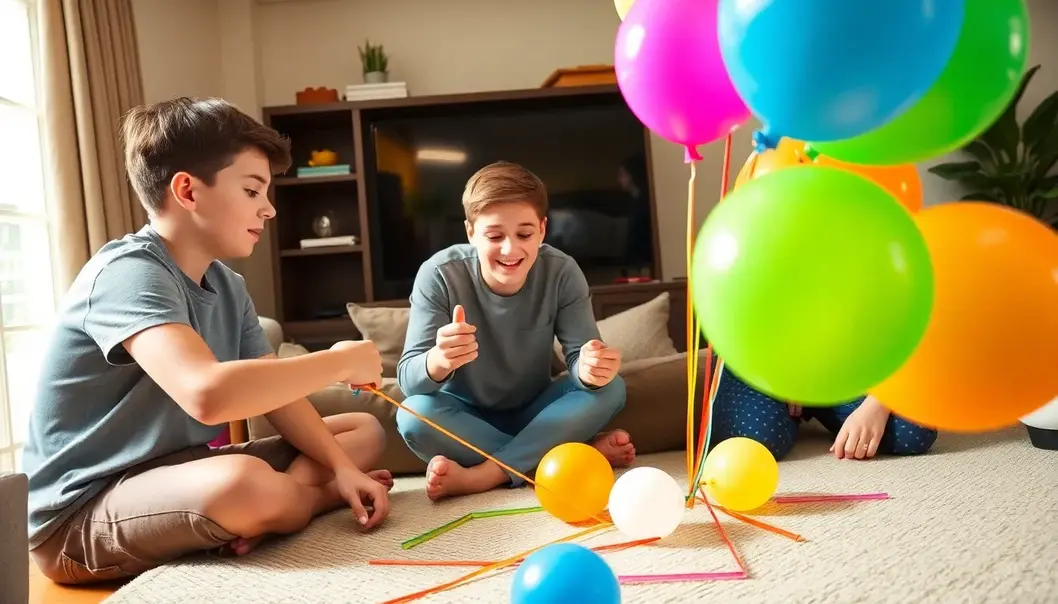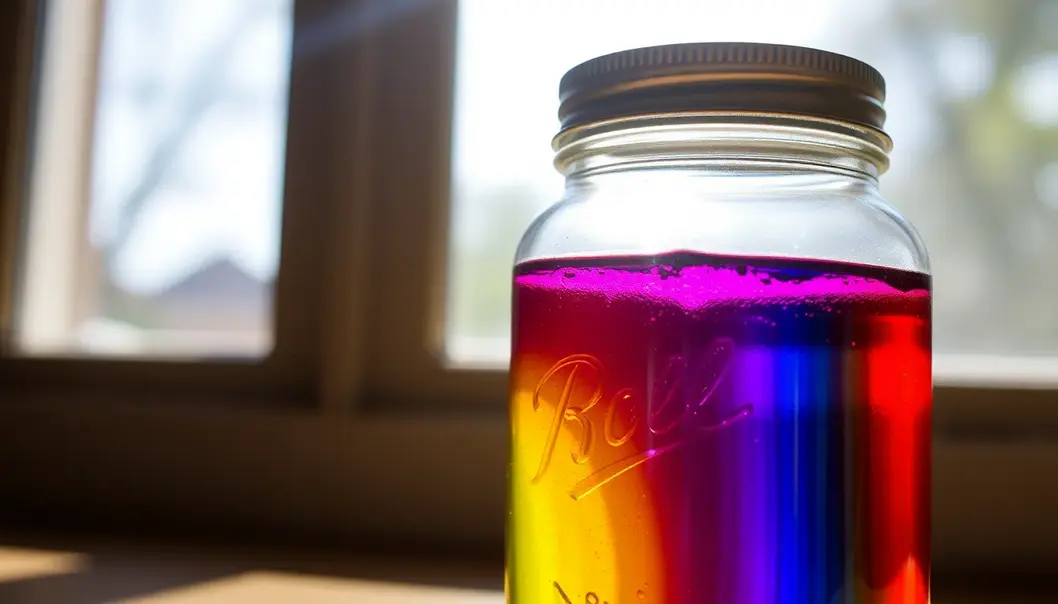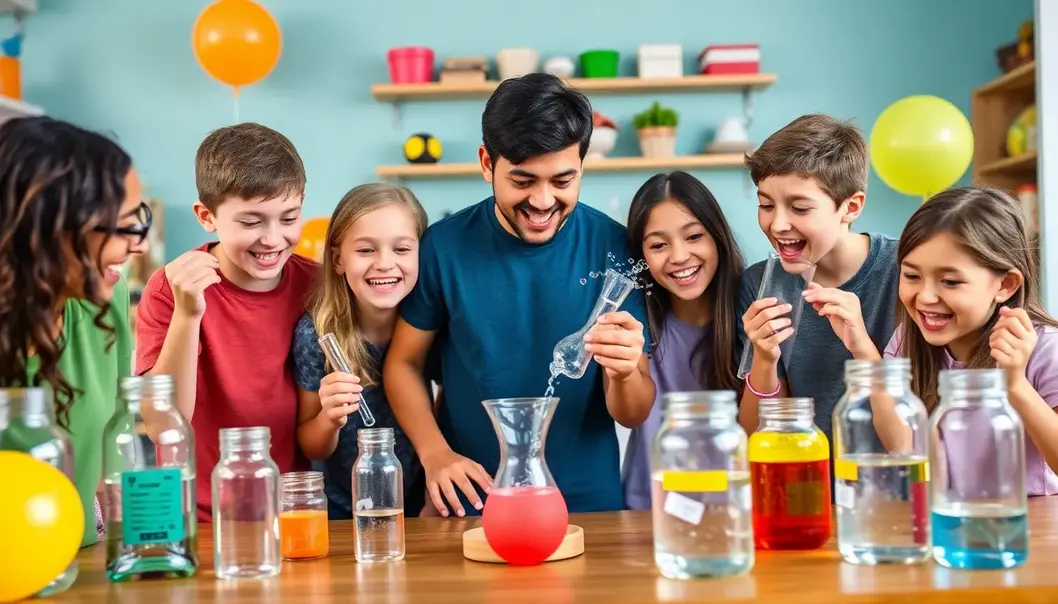Boredom buster alert! Dive into a world where science gets totally epic—and safe to do in your living room. If you’ve ever wondered how to make a rocket using items from your kitchen or wanted to create rainbow-colored explosions in a jar, you’re in the right place! These experiments don’t just keep you entertained and your parents proud; they dive deep into the wonderful, colorful world of science, igniting curiosity and excitement. So grab your goggles, put on your lab coat, and let’s get experimenting. Ready? Set? Go mad science!
Balloon-Powered Rocket

If you’ve ever dreamed of launching a rocket but felt limited by space or resources, you’re in luck. With just a few simple materials, you can transform your living room into a launchpad for a high-flying experiment that demonstrates the principles of propulsion and Newton’s Third Law. Get ready to send a colorful balloon rocketing across the room with this captivating activity.
Here’s what you’ll need to get started: string, a straw, some tape, and a colorful balloon. Begin by cutting a piece of string as long as your space allows—ten feet is often a good length. Tie one end to a doorknob or another stable object. Thread the other end of the string through a straw, creating the “rocket launch system.” Secure the straw onto the string but leave it free to glide.
Now, for the fun part! Inflate the balloon but avoid tying its neck—a simple hold will suffice. Use tape to attach the inflated balloon to the straw. Make sure it’s secure, but don’t squish the balloon, as it must expand and contract freely. Position the straw and balloon assembly at one end of the string.
Propulsion at Play
When you release the balloon, observe as it zooms along the string. What you’re witnessing is Newton’s Third Law of Motion in action: for every action, there is an equal and opposite reaction. The escaping air propels the balloon forward, converting potential energy stored in your lungs into kinetic energy as the balloon races forward.
Experimentation Time
To give this experiment an extra layer of discovery, experiment with different balloon sizes. Compare how a small balloon’s quick, short burst of speed differs from a larger balloon’s steadier, longer glide. You might even try varying the string’s angle by placing one end higher up to study the effects of gravity on propulsion.
This engaging activity not only brings scientific principles to life but also encourages creativity as you tweak variables to see how they affect outcomes. Who knew that rockets could be as light as air and as colorful as a candy store?
Expand your scientific exploration further by considering environmental factors, too. How does the weight or type of straw and tape affect the balloon’s journey? Each modification is an opportunity to hypothesize, test, and learn—the very heart of scientific inquiry. So gather your materials and ignite your curiosity today!
Rainbow in a Jar

Creating a rainbow in a jar is a visual treat and an engaging way to explore density! This colorful experiment uses ordinary household items to deliver extraordinary results, offering a hands-on lesson in science. Gather your materials: water, sugar, food coloring, a spoon, and a tall transparent jar.
Start by preparing your solutions. Take five or six cups of water and line them up in a row. In the first cup, mix in one tablespoon of sugar, and in the second, add two tablespoons. Keep increasing the amount of sugar in each subsequent cup until the final one has the most. Stir each cup thoroughly until the sugar is completely dissolved.
Now here comes the colorful part! Add different food colorings to each cup. Choose vibrant and contrasting colors to capture the essence of a rainbow. For example, use red, orange, yellow, green, blue, and purple. This will make your density layers pop in the jar.
The key to creating a layered rainbow is careful pouring. Take the cup with the most sugar (highest density) and pour it into the jar. Then using a spoon, very gently layer the next densest solution over the back of the spoon so it pours evenly and doesn’t mix too much. Continue this process, ensuring each subsequent solution is added slowly and rests above the previous one.
As each layer settles, you’ll witness a stunning spill of colors forming a true rainbow. Each layer, with its unique density, prevents the colors from mixing too quickly, allowing for this magical effect. Light reflects off the layers, making the rainbow appear as though it dances when the sun catches it just right.
Watching your rainbow take shape inside the jar is a mesmerizing experience and a testament to the scientific principle of density differences. The sugars dissolved in water increase the density, enabling the liquids to sit atop one another distinctly. This experiment not only demonstrates density but also sparks curiosity and enchantment, showing how science can transform the ordinary into something beautifully captivating.
Final words
With these fun science experiments, exploring fundamental scientific principles becomes an exciting adventure. From testing propulsion with balloons to layering liquids to form a rainbow, science is fun and accessible at home. So keep experimenting, and remember—each discovery brings you closer to a brighter, more knowledgeable tomorrow.
Ready to go further in your scientific journey? Check out our monthly subscription for exclusive DIY experiment kits delivered to your door!
Learn more: https://www.sciencekitforyou.com/subscription
About us
Science Kit For You offers curated monthly science kits with everything you need for incredible DIY experiments at home. Each box is filled with fun, easy-to-follow projects crafted by real scientists that inspire learning by doing.

